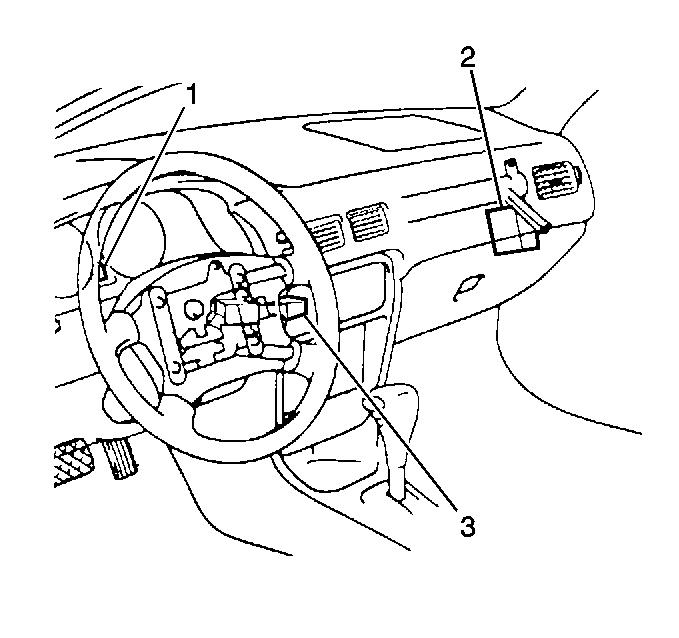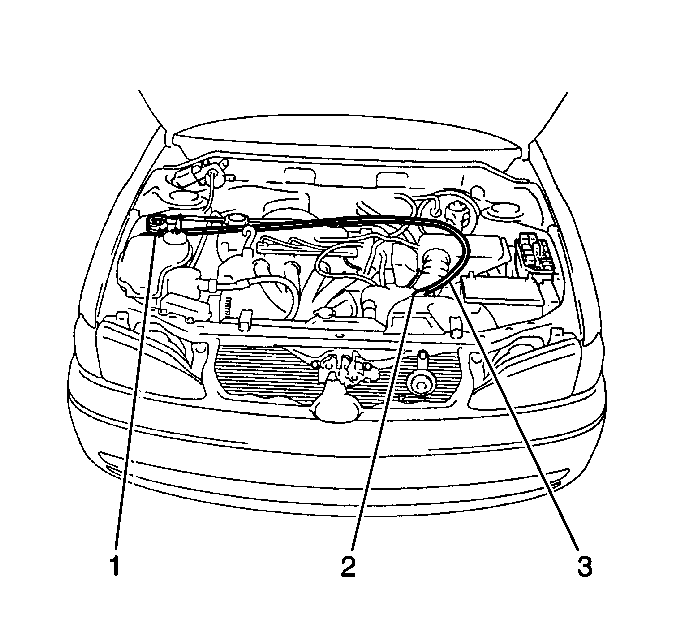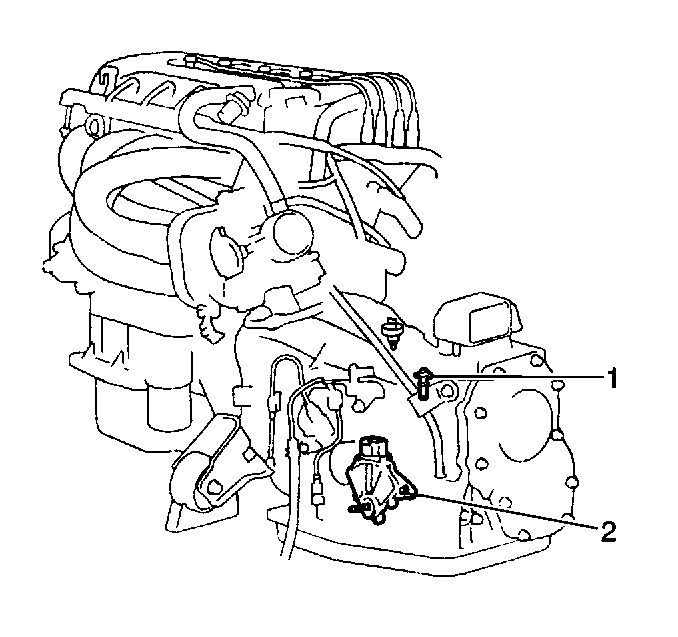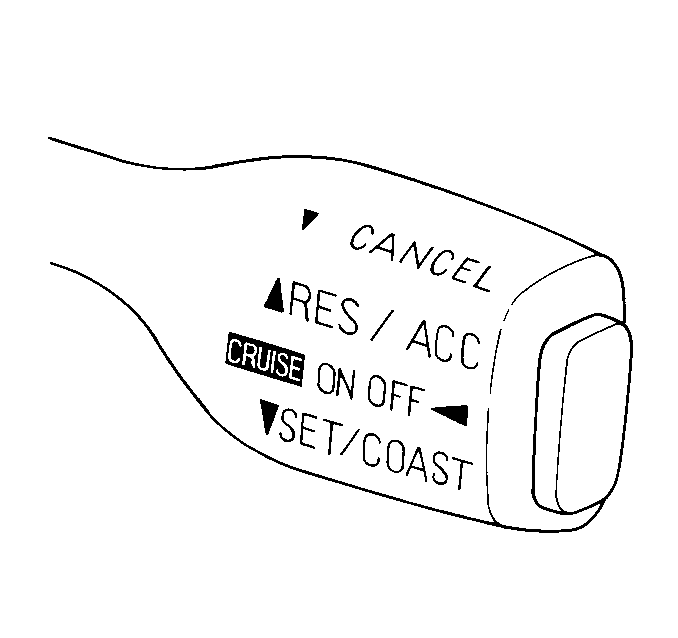Caution: Do not use the cruise control on slippery roads, steeply graded roads, or in heavy traffic of heavy or varying volume. Failure to follow these CAUTIONS could possibly cause you to loose control of the vehicle and result in damage to the vehicle and personal injury.
Cruise control is a speed control system that maintains a desired vehicle speed under normal driving conditions. However, steep grades up or down may cause variations in the selected speeds. This cruise control system has the capability to cruise, coast, resume speed, accelerate, and tap-up and tap-down.
The main components of the cruise control system are the cruise control module, the servo, the cruise control switch and the Vehicle Speed Sensor (VSS).
The cruise control module and the servo are the two main components that allow the system to control and maintain the desired vehicle speed. The cruise control module monitors vehicle speed and provides the cruise control servo with the necessary commands to maintain or change vehicle speed in response to inputs from the cruise control switch. Upon receiving a command, a DC servo motor inside the servo turns a worm gear which, in turn, moves the accelerator cable to adjust throttle angle. The DC servo motor and the worm gear are mechanically connected only when a magnetic clutch, situated between them is energized by the cruise control module.
Cruise control operation is disengaged when the cruise control module receives a cancel signal from the stoplamp switch, the cruise control switch, the Park/Neutral Position (PNP) switch (A/T), or the cruise control release switch (M/T). Upon receiving a cancel signal, the cruise control de-energizes the magnetic clutch inside the cruise control servo. With the magnetic clutch de-energized, the DC servo motor and worm gear are no longer mechanically connected and the throttle returns to the idle position.
Cruise Control Module Description
The cruise control module (2) is located to the right of the instrument panel compartment. The main function of the cruise control module is to monitor and act upon input signals from the cruise control switch and the Vehicle Speed Sensor (VSS).

There are four different categories of input signals received by the cruise control module. These four categories are ON/OFF, speed control, throttle position and cancel. The ON/OFF input signal to the cruise control module is provided by the cruise control switch and simply activates and de-activates the cruise control system. The speed control input signals to the cruise module are provided by the cruise control switch and the VSS. Speed control input signals are provided by the cruise control switch are the RES/ACC (Resume/Accelerate) signal and the SET/COAST signal. These signals are also used to initiate the tap-up and tap-down functions. The cruise control module uses these signals, in addition to the vehicle speed signal from the VSS, to determine and maintain or alter vehicle speed in accordance with the driver's commands. The throttle position signals to the cruise control module are provided by the servo and the idle switch inside the Throttle Position (TP) sensor. These signals, as their names suggest, allow the cruise control module to constantly monitor throttle position during cruise control system operation. The cancel input signals to the cruise control module are provided by the cruise control switch CANCEL signal, the stoplamp switch, the PNP switch, or the cruise control release switch. These input signals inform the cruise control module that cruise control operation should be immediately suspended.
Output signals from the cruise control module are all sent to the cruise control servo and will vary depending upon the type of input signals received. If, for example, the cruise control module senses that vehicle speed has dropped below the desired cruise speed, an output signal will be sent to the OPEN side of the DC servo motor within the cruise control servo. This action will cause the motor to turn the worm gear, open the throttle, and increase vehicle speed until the desired cruise speed is activated. If the cruise control module should sense that vehicle speed is above the desired cruise speed, an output signal is sent to the CLOSE side of the DC servo motor within the cruise control servo. This action will cause the motor to turn in the opposite direction, close the throttle, and decrease vehicle speed until the desired cruise speed is achieved. Finally, should a cancel input signal be received, the cruise control module de-energizes the magnetic clutch within the servo. This action disengages the DC servo motor from the worm gear, causing the throttle to go to the idle position and effectively canceling cruise control operation.
The cruise control module also has a self-diagnostic capability. In conjunction with the cruise control switch, it can be used to run an abbreviated self-test which covers all cruise control switch positions, the stoplamp switch, the PNP switch, the cruise control release switch, and the VSS. In addition to the abbreviated self-test, grounding the Tc terminal in the Data Link Connector (DLC) allows the cruise control module to flash Diagnostic Trouble Codes (DTCs) on the CRUISE indicator. By reading the DTCs and following the diagnostic tables, any electrical problem in the cruise control system can be identified and repaired.
Servo Description

The servo (1) is mounted to the right strut tower and consists of a DC servo motor, a worm gear, a throttle angle sensor (potentiometer) and a magnetic clutch. Acting in response to signals from the cruise control module, the servo's DC servo motor actuates the accelerator cable to increase and decrease throttle angle.
Vehicle Speed Sensor Description
The VSS is an electronic relay that is mounted on the transaxle. As the transaxle turns the VSS, the VSS provides the speedometer with a vehicle speed input (voltage pulses). This input is used to drive the speedometer. The speedometer then converts the Vehicle speed input into a more precise waveform and provides the Powertrain Control Module (PCM) and the cruise control module with its own vehicle speed input. The cruise control module converts this input into a vehicle speed. For vehicle speed sensor replacement procedures, refer to Vehicle Speed Sensor Replacement in Automatic Transmission - 3 Speed, Vehicle Speed Sensor Replacement in Automatic Transmission - 4 Speed or Vehicle Speed Sensor in Manual Transmission - MB4 and MB5.
Clutch Control Release Switch Description
The cruise control release switch is mounted under the instrument panel directly above the clutch pedal. Whenever the clutch pedal is pressed, the cruise control release switch closes and provides a ground to the cruise control module. The cruise control module disengages cruise control system operation as soon as this ground signal is sensed.
Park/Neutral Position (PNP) Switch Description

The PNP switch (2) is mounted to the transaxle. Whenever the manual selector lever is placed in either the Park (P) or Neutral (N) position, the PNP switch closes and provides a ground to the cruise control module. The cruise control module disengages cruise control system operation as soon as this ground signal is sensed. For PNP switch replacement and adjustment procedures, refer to Park/Neutral Position Switch in Automatic Transaxle - 4 speed or Park/Neutral Position Switch Replacement in Automatic Transaxle - 3 speed.
Stoplamp Switch Description
The stoplamp switch is located under the instrument panel directly above the brake pedal. Whenever the brake pedal is pressed, one set of stoplamp switch contacts close and a voltage signal is provided to the cruise control module. The cruise control module disengages cruise control system operation as soon as this voltage signal is sensed.
When the brake pedal is pressed, another set of stoplamp switch contacts open, and the voltage circuit from the cruise control module to the magnetic clutch inside the servo is interrupted. With voltage removed from the magnetic clutch, the servos DC servo motor is disengaged from the worm gear and the throttle is permitted to return to the idle position. This feature is provided to ensure the cancellation of cruise control system operation during vehicle braking. For stoplamp switch replacement and adjustment procedures, refer to Stop Lamp Switch Replacement in Hydraulic Brakes.
Throttle Position (TP) Sensor Description
The TP sensor is located on the throttle body. Whenever the throttle is in the idle position, the idle switch contacts within the TP sensor close and provide a ground signal to the cruise control module.
Cruise Indicator Description
The CRUISE indicator, located in the instrument cluster assembly, turns ON to inform the driver that the cruise control system is operational. The CRUISE indicator is also used during cruise control system diagnosis.
Powertrain Control Module (PCM) Description
On vehicles equipped with the four speed automatic transaxle, the cruise control module receives a shift solenoid number 2 signal. This signal informs the cruise control module that the transaxle is in second or third gear and is out of the OVERDRIVE mode.
Cruise On-Off Switch

The cruise on-off switch is a momentary contact type button located on the end of the cruise control switch. The purpose of the cruise on-off switch is to turn the cruise control system ON and OFF.
RES/ACC Switch

The RES/ACC (Resume/Accelerate) switch returns cruise control system operation to the last speed setting after a cancel input signal is received by the cruise control module (such as vehicle braking). This switch is activated when the cruise control switch is momentarily moved upward. Do not hold the cruise control switch in this position. Release it immediately. If the cruise control switch is held in the RES/ACC position for more than one second, the system goes into the accelerate mode. If acceleration during cruise control system operation is desired, move the cruise control switch upward into the RES/ACC position and hold it there until the vehicle reaches the desired speed. When the cruise control switch is released, the cruise control system will maintain the new cruise speed. In order to use the accelerate mode, the cruise on-off switch button must have been pressed, the CRUISE indicator must be lit, and the vehicle speed must be over 40 km/h (25 mph).
The RES/ACC switch can also be used to tap-up vehicle speed. In order to do this, the cruise control system must be engaged and operating. Tapping-up is performed by quickly moving the cruise control switch up into the RES/ACC position and releasing it (or tapping the switch into the RES/ACC position). Do not hold the cruise control switch in the RES/ACC position, or the cruise control system will enter the accelerate mode. Tap-up is a function in which cruise speed can be increased by 1.6 km/h (1 mph) increments (one tap = 1.6 km/h [1 mph] increase).
SET/COAST Switch

The SET/COAST switch is activated when the cruise control switch is moved downward into the SET/COAST position. When the cruise control switch is moved downward into the SET/COAST position and released, the cruise speed will be set at the speed at which the vehicle was traveling when the switch was activated. In order for this switch to operate, however, the cruise on-off switch button must have been pressed, the CRUISE indicator must be lit, and the vehicle speed must be over 40 km/h (25 mph).
The SET/COAST switch can also be used to decrease the cruise speed. By moving the cruise control switch downward into the SET/COAST position and holding it there, the cruise control system will disengage and allow the throttle to return to the idle position. When the new, lower cruise speed has been reached, the cruise control switch is released from the SET/COAST position. Once released, the cruise control system will re-engage and maintain the new desired cruise speed.
The SET/COAST switch can also be used to tap-down vehicle speed. In order to do this, the cruise control system must be engaged and operating. Tapping-down is performed by quickly moving the cruise control switch down into the SET/COAST position and releasing it (or tapping the switch into the SET/COAST position). Do not hold the cruise control switch in the SET/Coast position, or the cruise control system will enter the coast mode. Tap-down is a function in which cruise speed can be decreased by 1.6 km/h (1 mph) increments) (one tap = 1.6 km/h [1 mph] decrease).
The accelerator may be pressed at any time to override cruise control system operation. Release of the accelerator will return the vehicle to the previously set cruise speed.
